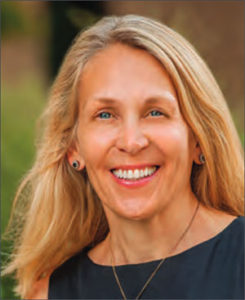This article originally appeared in The Bar Examiner print edition, Winter 2019-2020 (Vol. 88, No. 4), pp 3–5.
By Judith A. Gundersen
 2010–2020: A Look Back and a Preview of What’s Ahead
2010–2020: A Look Back and a Preview of What’s Ahead
2020—this first year of the new decade, with its “perfect vision” metaphor—exhorts us to look at where NCBE and our admissions partners have been over the past decade, where we are headed, and what we’ve learned along the way.
Looking Back on the 2010s
The UBE—Bar Exam Reform that Crept Up on Us
The 2010s saw something of a steady (r)evolution in lawyer licensing as mobility and uniformity became the norm rather than the exception. The launch and growth of the Uniform Bar Examination (UBE)—a uniformly administered and scored exam—meant that, by the end of the decade, over 135,000 law school graduates had earned the ability to transfer their bar exam scores to another jurisdiction.
That recent graduates no longer had to take multiple exams for multiple admissions and that their potential job market grew from one jurisdiction to dozens was a game changer for graduates and newly licensed lawyers, their law schools, and the profession. The UBE has not only enhanced new lawyer mobility but has benefited examinees through the high-quality tests and uniform scoring that it brings to the bar admissions process.
Perhaps back in 2011, the policy makers in Missouri and North Dakota (the first and second jurisdictions to adopt the UBE) had the foresight to know that less than 10 years later, they would be joined by 34 other UBE jurisdictions, with still others considering adoption—but I personally am still pleasantly surprised by the growth of the UBE, considering how bar exams had traditionally been developed on a state-by-state basis.
And out of those 135,000 UBE scores earned thus far, over 20,000 scores have been transferred to other UBE jurisdictions over the past decade. That’s about 15% of all UBE scores, a percentage that is creeping up each year, signaling that more examinees are taking advantage of the ability to transfer their scores to where the jobs are.
Boom and Bust Bar Exam Score and Law School Enrollment Trends
The 2010s took us on a roller-coaster ride amid falling numbers of examinees, declining bar passage rates, and shrinking law school enrollment.
A snapshot of bar exam trends in the 2010s:
- In 2013, over 75,000 people sat for the bar exam—the highest number ever. The July MBE mean that year was 144.3—the third-highest MBE mean ever recorded.1
- By 2015, there were approximately 70,000 examinees; and by 2018, just over 66,000—a 12% decrease from the 2013 peak.
- Over roughly that same time, bar exam scores declined: the 2018 cohort of examinees (likely matriculating in 2015) recorded the second-lowest July MBE mean score on record, 139.5; and the February 2018 examinees recorded the lowest-ever MBE mean score on record, 132.8.2
- On a happier note, bar exam results were up in both February and July 2019. In July, MBE scores improved by 1.6 points to 141.1, with first-time takers’ MBE mean up 2.2 points over the July 2018 mean. Forty-seven of the 52 jurisdictions using the MBE in July 2019 saw their MBE means rise.3
A snapshot of law school enrollment trends in the 2010s:
- In 2010, 1L enrollment peaked at 52,488 students.4
- By 2015, 1L enrollment was at 37,058, a nearly 30% drop from the 2010 peak.5
- 1L enrollment rebounded in 2018 and 2019, with over 38,000 1L students for each year.6
- While the number of JD students declined, the number of students enrolled in non-JD programs rose, from about 9,800 students in 2010 to close to 20,000 in 2019.7
NCBE in the 2010s
Over the 2010s, NCBE became a bona fide testing organization by assuming sole responsibility for test development and scoring for all four of our exams. NCBE had already assumed responsibility for MEE and MPT test development and operations in 2005 and for MPRE equating and MBE test development in 2009; in 2011 we took on MBE scoring and equating duties, developing proprietary item banking and scoring systems and hiring more measurement, development, and administrative staff to work with jurisdictions and our network of outside subject-matter-expert drafters.
The 2010s also saw many more developments at NCBE:
- In 2011 and 2012, as part of a content validity study for its exams, NCBE undertook a job analysis with the help of an outside consultant to determine what new lawyers do and what knowledge, skills, and abilities newly licensed lawyers believe that they need to carry out their work. As a result, the subject of Negotiable Instruments was eliminated from the Multistate Essay Examination in 2015, and every drafting committee for the MBE, the MEE, and the MPRE carefully reviewed its subject matter outlines; in some cases, outlines were reorganized to align with the job analysis.
- In 2012 NCBE launched the NCBE Number, a unique identifier now used by nearly every jurisdiction in lieu of a Social Security number for MBE answer sheets, scores, and other admission-related purposes.
- In February 2015, Civil Procedure was added as the seventh subject tested on the MBE (it already appeared on the MEE and was tested in virtually all jurisdictions’ essay portions of the bar exam).
- August 2017 saw a change in leadership at NCBE, which was quickly followed by the creation of NCBE’s Testing Task Force, charged with undertaking a three-year study to ensure that the bar examination continues to test the knowledge, skills, and abilities required for competent entry-level practice. Phase 2 of the Task Force’s study consisted of another, more comprehensive nationwide practice analysis, completed in 2019. (See testingtaskforce.org.)
- NCBE developed and debuted in 2018 a new version of the Online Character Report Application currently used by 26 jurisdictions.
- In late 2018, NCBE began partnering with the Council on Legal Education Opportunity (CLEO) to help it fulfill its mission to enhance bar readiness for students from historically underrepresented groups. We are pleased to continue that relationship into the new decade.
- Throughout the decade, NCBE continued offering a wide range of educational events as a service to our stakeholders, ranging from UBE regional meetings and forums, to mini-seminars for new bar administrators, to conferences for legal educators and bar examiners promoting best practices in testing. NCBE continued its efforts at outreach and collaboration with other stakeholders by cosponsoring with the Law School Admission Council a conference for legal educators in February 2019. In September 2019, NCBE hosted a conference for academic support professionals.
- NCBE also continued expanding its offerings of high-quality, affordable study aids for all four exams during the decade, culminating in the 2019 launch of BarNow, a new mobile-friendly eLearning platform (see ncbex.org/study-aids).
- Also during the past decade, our testing department not only managed (and continues to manage) ongoing program responsibility for our four exams, but our researchers and psychometricians also engaged in research and behind-the-scenes work for many jurisdictions on a regular basis at no cost to the jurisdictions. (See this issue’s Testing Column for an example of the type of research we’ve conducted.)
- And in August 2019, NCBE successfully launched its inaugural computer-based administration of the MPRE, with over 4,000 candidates taking the MPRE at Pearson VUE centers across the country in preparation for the full transition to computer-based testing in the new decade.
- We’ve ended the decade by putting increased emphasis on communication to all stakeholders, including being active on social media and creating a new website devoted to this publication and admissions news and resources, thebarexaminer.org.
Looking Ahead to 2020 and Beyond
With all that has been accomplished in the 2010s, all of us at NCBE (and our staff now numbers 100!) begin the new decade with enthusiasm and a renewed sense of purpose to take on the many initiatives we have on the horizon. In 2021 NCBE will celebrate its 90th anniversary as the organization that is here to support and serve you in the bar admissions process to ensure that candidates demonstrate the needed qualifications to enter the legal profession.
On the immediate horizon is the first all-computer administration of the MPRE in March 2020, where candidates will take the MPRE at over 275 Pearson VUE centers around the country. Our move to computer-based testing is an important milestone and stepping-stone for us to enhance test security, strive for uniform administration, aid test development, and respond to consumer expectations in a digital world.
In the coming year we will expand the number of law schools to which we send aggregate MPRE score data for their internal assessment purposes.
In terms of educational offerings, our 2020 Annual Bar Admissions Conference, to be held in New Orleans April 30–May 3, promises to be rich in the topics of regulatory reform efforts, diversity and inclusion, testing fundamentals, and character and fitness, among others. We will also host an admissions conference in fall 2020 focused on the character and fitness process.
The Testing Task Force will publish its Phase 2 report (Practice Analysis Results) early in 2020 and begin Phase 3, bar examination blueprinting and test design. The Task Force’s study is scheduled to be completed by the end of 2020. Stay tuned as our study progresses and stakeholder input is sought by subscribing to Task Force updates at testingtaskforce.org/subscribe.
We look forward to keeping you up to date on our activities in 2020. Wishing you all the best for the new decade.
Notes
- The highest-ever MBE mean, 145.6, was recorded in July 2008. The MBE mean is a good proxy for bar exam results without having to take into consideration differing cut scores. (Go back)
- The lowest July MBE mean, 139.2, was recorded in 1984. (Go back)
- Mark A. Albanese, PhD, “The Testing Column: July 2019 MBE: Here Comes the Sun; August 2019 MPRE: Here Comes the Computer,” 88(3) The Bar Examiner (Fall 2019) 33–35. (Go back)
- American Bar Association Section of Legal Education and Admissions to the Bar, Statistics Archives, ABA Required Disclosures, https://www.americanbar.org/groups/legal_education/resources/statistics/statistics-archives/. (Go back)
- 2015 Standard 509 Information Report Data Now Available, https://www.americanbar.org/content/dam/aba/administrative/legal_education_and_admissions_to_the_bar/governancedocuments/2015_fall_enrollment_announcement.pdf. (Go back)
- 2019 Standard 509 Information Report Data Overview (posted 12/12/2019), https://www.americanbar.org/content/dam/aba/administrative/legal_education_and_admissions_to_the_bar/statistics/2019-509-enrollment-summary-report-final.pdf. (Go back)
- American Bar Association Section of Legal Education and Admissions to the Bar, Statistics, ABA Required Disclosures, https://www.americanbar.org/groups/legal_education/resources/statistics/; Law School Transparency, Data Dashboard, Law School Enrollment, https://data.lawschooltransparency.com/enrollment/all/?scope=national. (Go back)
Until the next issue,

Judith A. Gundersen
Contact us to request a pdf file of the original article as it appeared in the print edition.







